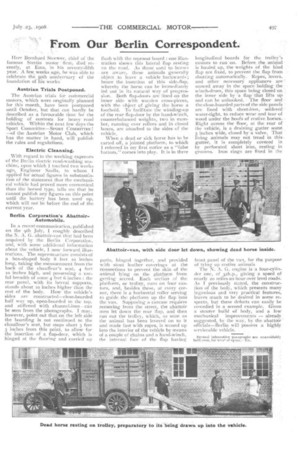From Our Berlin Correspondent.
Page 15

If you've noticed an error in this article please click here to report it so we can fix it.
Herr Bernhard Stocwer, chief of the famous Stettin motor -firm, died • recently, at Ems, in his seventy-fifth year. • A few weeks ago, he was able to celebrate the .50th -anniversary of the foundation of his works Austrian Trials Postponed.
The Austrian trials for conamercial motors, which were originally 'planned for this month, have been postponed until October, but that can hardly be described as a favourable time for the holding of contests for heavy road vehicles. Within the next few days the Sport Committee—SPORT CommiTTRE! —of the Austrian Motor Club, which has the matter in hand, will publish the rules and regulations.
Electric Cleansing.
With regard to the working expenses of the Berlin electric road-washing machine, upon which I touched two weeks ago, Engineer Szalla, to whom I applied for actual figures in substantiation of the statement that the mechanical vehicle had proved more economical than the horsed type, tells ins that he cannot publish any figures on this point until the battery has been used up, which will not be before the end of the current year.
Berlin Corporation's Abattoir. Automobile.
In a recent communication, published on the gth July, I roughly described the N.-A. G. abattoir-van that had been acquired by the Berlin Corporation, and, with some additional information about the vehicle, I now forward illustrations. The superstructure consists of a box-shaped bob, 8 feet to inches long, taking the measurement from the back of the chauffeur's seat, 4 feet in inches high, and possessing a useful breadth of some 4 feet 6 inches : the rear panel, with its lateral supports, stands about to inches higher than the rest of the body. How the vehicle's sides are constructed—close-hoarded half way up, open-boarded to the top, and stiffened with channel-iron—can be seen from the photographs. I may, however, point out that on the left side the boarding is not continued to the chauffeur's scat, but stops short 3 feet 3 inches from this point, to allow for the insertion of a flap-door, which is hinged at the flooring and carried up
flush with the topmost board : one illustration shows this lateral flap resting_ on the road. As those us.ed to horses are aware, these animals generally .object to leave a vehicle backwards ; hence the insertion of this side-flap, whereby the horse can he immediately led out in its natural way of pre.gression. Both flap-doors are lined on the inner side with wooden cross-pieces, With the object of giving the horse a foothold. To facilitate the winding-up of the rear flap-door by the hand-winch, counterbalanced weights, two in number, running over rollers and in _closed boxes, are attached to the sides of the vehicle.
When a dead or sick horse has to be carted off, a jointed platform, to which I referred in my first notice as a "false bottom,'' comes into play. It is in three
parts, hinged together, and provided with stout leather coverings at the connections to prevent the skirt of the animal lying on the platform from getting scored. Each section of the platform, or trolley, runs on four castors, and, besides these, at every corner, there is a horizontal roller serving to guide -the platform up the flap into the van. Supposing a carcase requires removing -from the street, the abattoir men let down the rear flap, and then run out the trolley, which, as soon as the animal has been levered on to it and made fast with ropes, is wound up into the interior of the vehicle by means of a couple of Chains and -a hantLwinch, the internal face of the flap having longitudinal boards for the trolley's cs.tors to run 'on. • pefore_ the .aninfal is hauled up, the weights of the hind . flap are fixed, to prevent the .flap from shutting -automatically.Ropes., levers,. and other necessary applianees arestowed away in the space -balding the : winch-drum, this space being cloSed-on the inner side by • a flap that liftstip and can be unhooked. The floor th71.0. • the close-hoarded parts of the side panels are lined with sheet-iron, soldered water-tight, to reduce wear-and. tear of wood under the hoofs of restive horses... Right across the floor, at the rear of the vehicle, is a -draining gutter some 5 inches wide, closed by A valve. That living animals may not tread in this gutter, it is completely covered in by perforated sheet iron, resting in grooves. Iron rings are fixed in the front panel of the van, for the purpose of tying up restive animals The N. A. G. engine is a four-cylinder one, of 32h.p., giving a speed of nearly 20 miles an hour over level roads:. As I previously stated, the construction of the body, which presents many ingenious and very practical features, leaves much to be desired in some respects, but these defects can easily be remedied in a second example.. Given a stouter build of body, and a few mechanical improvements .— already suggested, by the way, by the abattoir officials—Berlin. will 'possess a highly serviceable vehicle. . •




















